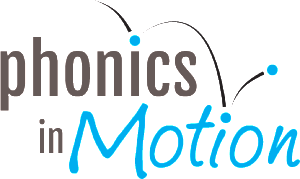Close your eyes. Picture a room filled with twenty 1st graders. Do you see twenty little people sitting still and completely focused on their teacher? Or an overwhelmed teacher who looks like she needs her third coffee of the morning? If you chose the second option, it may be time to integrate kinesthetic movement in […]
Read moreLearning in Motion: Fun with Phonics
Phonics in Motion is a unique learning program that incorporates kinesthetic techniques in addition to auditory and visual sensory information. Children do not have a “one size fits all” learning style, therefore educational experiences tailored to a child’s learning styles will have a beneficial result in their ability to acquire, retain, and master information. […]
Read moreAn Inclusive Classroom Benefits Students in All Stages of Early Literacy
Mark loves to build things. Lainey loves to act things out. Cameron loves to draw. Marquis is a dancer and loves to move! Research shows that an inclusive classroom benefits all students. When planning, we need to focus equally on what children learn, and how they learn. Learners have different learning styles to acquire knowledge, […]
Read moreMoving Beyond Sound Walls: PIM’s Approach to Reading Instruction
Traditionally, primary education classrooms have utilized word walls. While they may have been somewhat successful, literary science shows that early learners respond better to and have better learning outcomes from sound walls. The problem is, word walls are often not used frequently throughout the whole year. Why? Teachers end up ditching them when they realize […]
Read moreProviding A Safe Learning Environment For Improved Literacy Outcomes
We are a diverse society with an equally diverse learning population. Students arrive at school with varying degrees of knowledge and capabilities. Providing a safe learning environment is the first step in laying a solid educational foundation. As any kindergarten teacher can tell you, some students walk in on the first day with the ability […]
Read moreThe Power of Muscle Memory in Reading and Writing
Learning how to read and write is a difficult task for children. It takes time, patience, and practice. Muscle memory can help! Incorporating kinesthetic movement in the classroom will make learning fun while improving reading skills! The kinesthetic movement in the classroom approach has been proven to increase early literacy outcomes by providing opportunities […]
Read moreBrain-Based Learning: Changing The Way We Teach Kindergarten
Imagine a classroom where children are engaged and excited about learning to read and write. A space where they feel confident in their abilities and develop skills that will last them a lifetime. There is no such thing as boring seat work, but instead brain-based learning strategies so students can meet literacy educational outcomes […]
Read moreBuilding a Diverse Classroom: The Benefits in Early Literacy Education
Promoting diversity in a classroom can have a positive effect on the quality of education. This could include different talents, experiences, and learning styles. Educators should be aware that some students may learn slower than others or at different speeds. By acknowledging this diversity and approaching it as something to celebrate rather than just […]
Read moreHow To Help A Child Struggling With Reading and Writing
How To Help A Child Struggling With Reading and Writing In your classroom, you may find yourself faced with a child struggling with reading and writing. The reasons for this are wide-ranging, as anything from lack of literacy exposure to difficulty with the ability to hear and record sounds can impact early literacy. The […]
Read more
